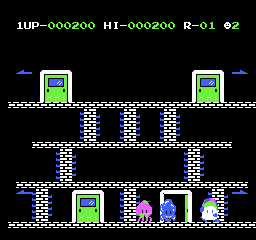Overview
DoorDoor is a puzzle game that was created by Koichi Nakamura, the man who would go on to create the venerable Japanese RPG company and Mysterious Dungeon developer Chunsoft. Putting players in the role of baseball cap-wearing Chun, the gameplay involves Chun trapping monsters behind doors, with different level layouts and monsters necessitating a variety of strategies to win.
Published by Enix, DoorDoor was one of the company's first forays into the video game marketplace, having been created as the result of Enix's first “Game Hobby Program Contest” held in Japan to find the company's first products to release. The game was one of the thirteen contest winners and was published in February 1983 along with all the other finalists. Initially released for the NEC PC-88 and other Japanese computers, DoorDoor was later ported by Chunsoft to the Famicom in 1985, making it Enix's first game to be released for home consoles.
Gameplay
 Chun tries to lead the monsters towards a door.
Chun tries to lead the monsters towards a door.DoorDoor's gameplay entails luring monsters into open doors that can then be shut, permanently trapping them for the remainder of the level and boosting the player's score. Since the monsters otherwise stalk Chun in a manner similar to Pac-Man's eternally pursuing ghosts, much of the gameplay revolves around taking advantage of their path-finding programming and other unique characteristics in order to defeat them. Some creatures have more overt special abilities such as the ability to jump with the same timing as Chun, while others are more subtle, possessing things as simple as slightly faster running speeds.
DoorDoor's major source of puzzle solving in addition to the monsters and their routines lies in the doors themselves. Given that most of the doors only open and close in one way, the monsters must first be brought to the door from a specific direction. Only once they enter it can the door then be fully closed by having Chun walk over it from the opposite direction. While multiple monsters can be trapped behind one door, doing so can be a gamble; monsters that are inside a door that is still open will only stay in there for a few seconds. If the player is too slow to close the door, the monster will reenter the level, possibly killing Chun in the process if he happens to be nearby. Doors that have also been used to previously trap a monster cannot be opened once they have something inside.
Dying, however, does not result in the respawning of all monsters, as only the monsters that were still free will remain when the level restarts. Likewise, the doors that were used to trap monsters can be used once again to capture the remaining ones. In scenarios where the player still has monsters roaming but no usable doors remaining, this is a mechanic that sometimes has to be exploited, something that was deliberately designed into the game and its level layouts.
History
The release of DoorDoor came about as the result of Enix needing a game to publish as its first push into the Japanese video game marketplace. Given that the company was not originally intended to have video games designed and released by internal teams, it was necessary to recruit outside talent. In order to accomplish this objective. Enix decided to hold a national contest for programmers. Out of that contest came the first game created by Koichi Nakamura, a high schooler at the time, who submitted DoorDoor as his entry. The title ended up winning the "Excellent Program Award" which was the second biggest award in the contest that was given to two winners with 500,000 yen in prize money. After Enix acquired the rights to the game, it became a major hit, selling over 200,000 copies. This process of finding outside help to create and sell games instead of always doing it within the company helped lay the groundwork and standards to come in future developer-publishing relationships throughout the video game industry.
Log in to comment